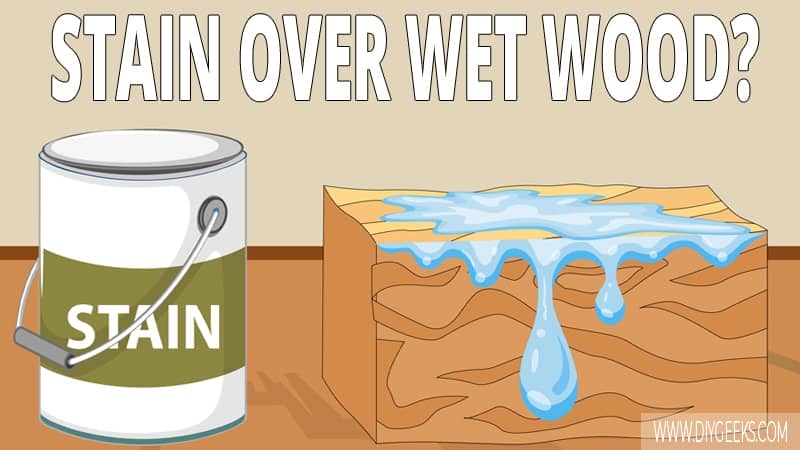Wet wood refers to a wooden surface that contains a high water or moisture amount. You can’t stain directly over wet wood as the surface moisture will prevent the wood stain from penetrating and adhering to it.
To stain over wet wood, dry the wood as much as possible, apply stain-blocking primer, and apply the wood stain.
Note: While some water-based stains can be applied over damp wood, the results won’t be as smooth or colorful as if the surface was dry.
Why Doesn’t Wood Stain Stick To Wet Wood?
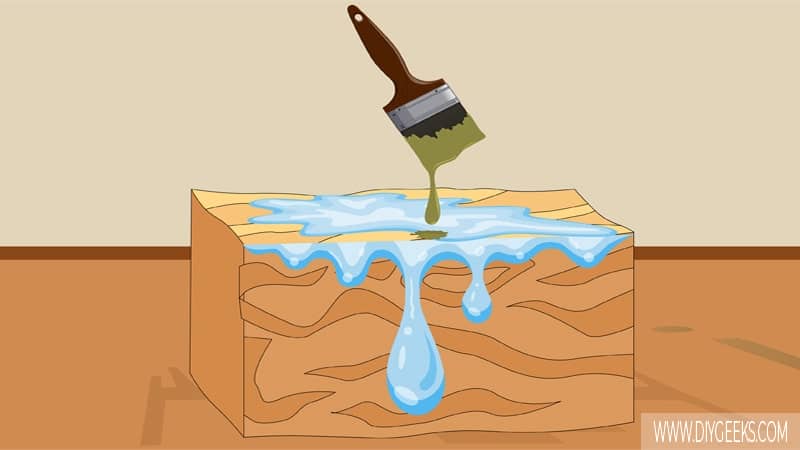
Wood stain doesn’t adhere over wet wood as the wood has a large oil and tannin deposits and its surface is wet which prevents the wood stain from penetrating and adhering.
Wood stain must penetrate the surface pores (or grain) to stick. If the pores of the surface are already filled with water (or moisture), the stain can’t penetrate them and won’t stick.
Oil-based stains especially don’t stick well because they use oil (natural or synthetic) as their solvent, and oil isn’t compatible with water.
What Happens if You Stain Wet Wood?
If you stain wet wood, the following things will happen.
- Harder Prepping Process.
- Poor Adhesion.
- Discoloration.
- Longer Dry Time.
- Tacky or Sticky Finish.
1. Harder Prepping Process
You must prep the surface before staining it. The prep work involves cleaning and sanding the surface, but you can only clean and sand dry surfaces.
If the wood is wet, you can’t clean it because the rag will be filled with wood oils. Also, you can’t sand it because the sandpaper will get clogged up. This makes prepping the surface difficult.
2. Poor Adhesion
Because of the high amount of moisture and dirt, the stain won’t stick.
3. Discoloration
Tannins, oils, and moisture in the wet surface will bleed through once the stain gets dry. This will make the finish appear blotchy as the color will be uneven. When this happens, you may also notice yellowing in the finish.
4. Longer Dry Time
The stain will take longer to dry because of the moisture on the surface. For a finish to dry, the solvent has to completely evaporate from the coating. But, since there’s moisture in the surface, the solvent takes longer to evaporate, which increases the drying time of the coating.
5. Tacky or Sticky Finish
The finish will turn sticky or tacky since it won’t dry properly. Bleed-through, poor adhesion, and tacky finish mostly happen when you apply oil-based stain over it. Water-based stains perform better than oil-based stains on damp wood, but the result will still be inferior.
How Long Does Wood Take To Dry?
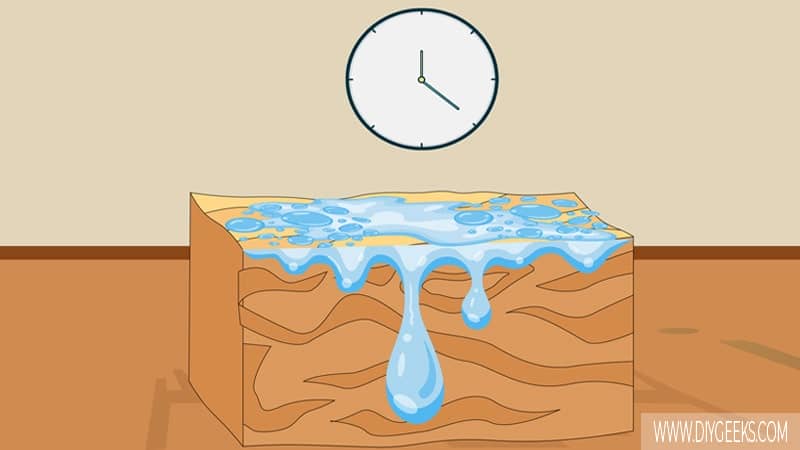
Wooden surface takes around 24 hours to dry enough before applying wood stain over it. Large surfaces like walkways, patios, and decks must dry for 3 days. This gives the surface enough time to dry so the wood pores can absorb a new finish.
The exact dry time depends on the type of wood, how much moisture is inside the pores, and the ambient temperature. For example, hardwood is porous and absorbs more moisture than other types, so it takes longer to dry.
The more absorbent the wood is, the more moisture it absorbs and the longer it will take to dry. Popular types of hardwood include Oak, Maple, and Pine.
Softwood will dry quicker and can be stained within 24 hours since the grain isn’t as absorbent as hardwood.
To know if the wood is dry enough, check the following things.
- Inspect the Surface: If the surface feels dry and hard, then it has properly dried and you can stain it. However, if the surface feels wet and moist, it hasn’t dried yet.
- Check Wood Fibers: Moisture tends to raise wood fibers causing splinters in the surface after it has dried. So if you can spot splinters in the wood, the surface has dried enough. If the surface is still wet, the splinters won’t appear.
- Check Moisture Levels: Use a moisture tester to measure how much moisture is inside the surface. If the moisture levels are lower than 15%, the surface is dry enough. If the moisture levels are higher than 15%, the surface hasn’t dried yet. You can also weigh the wood as it dries. The lighter it gets, the lower the moisture content is.
- Use Sandpaper: When you can sand it smoothly without the sandpaper getting stuck, the surface is dry enough.
Which Wood Stain Types To Use Over Wet Surfaces?
You must only use water-based stains over wet surfaces as they perform better because they are dissolved in water. So, the coating is compatible with moisture.
However, the coating will get lighter because of water, so only do it if there isn’t too much moisture on the surface.
Some deck stain types will also stick over damp surfaces as they are moisture-restaurant.
However, the finish you will get from applying stain over a damp surface will be inferior to the finish you’ll get if the surface is dry.
How To Stain Wet Wood?
To stain wet wood, do the following things.
- Prep the Work Area.
- Dry the Wood as Much as Possible.
- Apply Stain-Blocking Primer.
- Sand the Primer Coating.
- Apply Water-Based Wood Stain.
The tools you need for this project are listed below.
- A hairdryer
- Fine-grit sandpaper
- Stain-blocking primer
- Water-based stain
- A paintbrush or spray gun
- Drop sheets
- Waterproof sandpaper
- A pair of gloves
2. Dry the Wood as Much as Possible
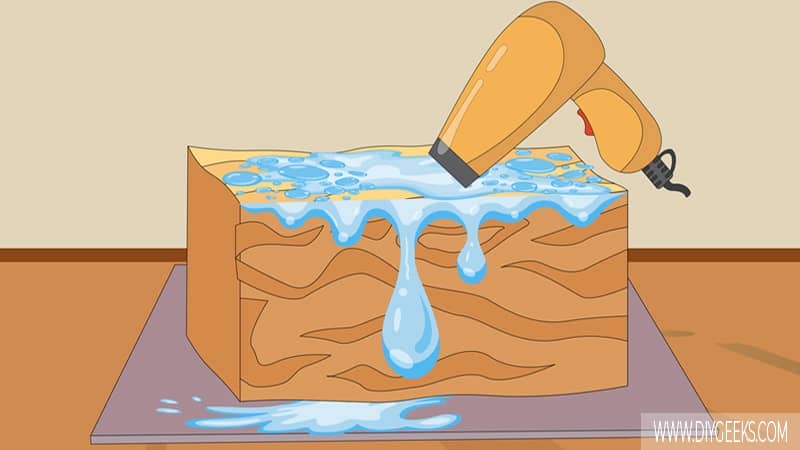
Dry the wood by increasing the ambient temperature around it with a hairdryer or exposing it to sunlight. The increased heat, exposure to sunlight, and dry air will make the wood dry faster.
2. Apply Stain-Blocking Primer
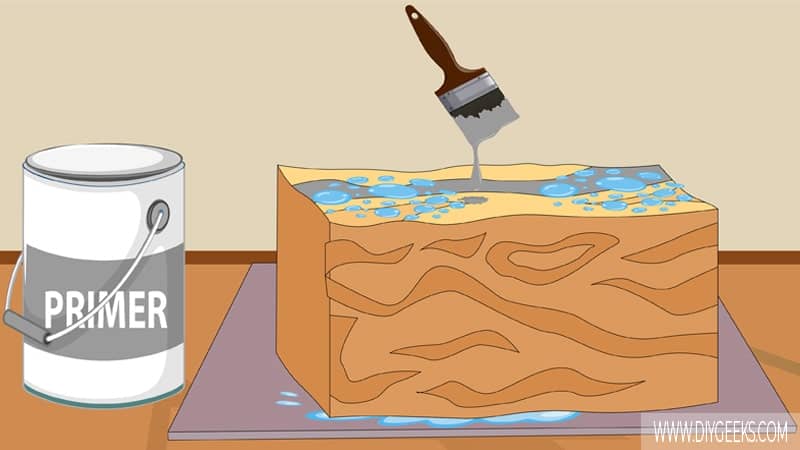
Apply one (1) thin stain-blocking primer over the wooden surface before applying the wood stain. The primer coating prevents the surface moisture from affecting the new stain finish but also covers the surface texture and patterns.
5. Apply Wood Stain
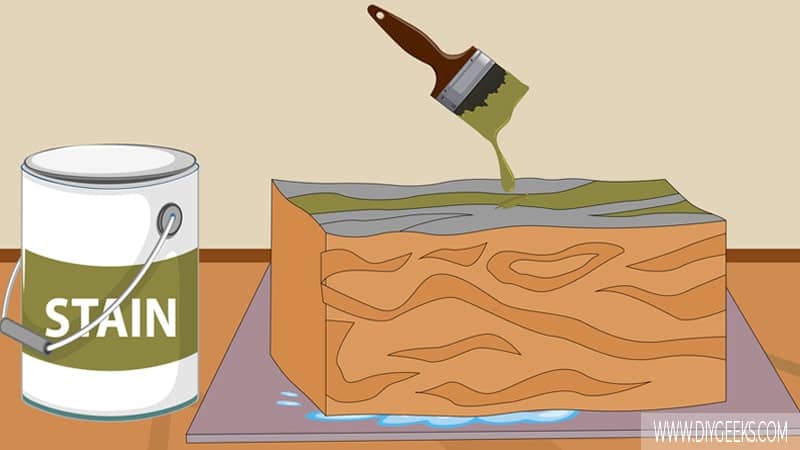
Apply two (2) wood stain coatings once the wooden surface completely dries. Wait until one coat dries before applying the next one.
Seal the stained wood finish with polyurethane or varnish to increase its durability and moisture-resistance.
How Long After Rain Can You Stain Wood?
You must wait at least 3 days after rainfall before you can stain wood or deck. Especially, if the wood doesn’t have any moisture-resistant layer on it.
If there is a moisture-resistant layer on the wood, let the wood dry for 24 hours. The moisture-resistant coating prevents the wood grain from absorbing high moisture content. So the wood will dry faster and can be stained sooner.
